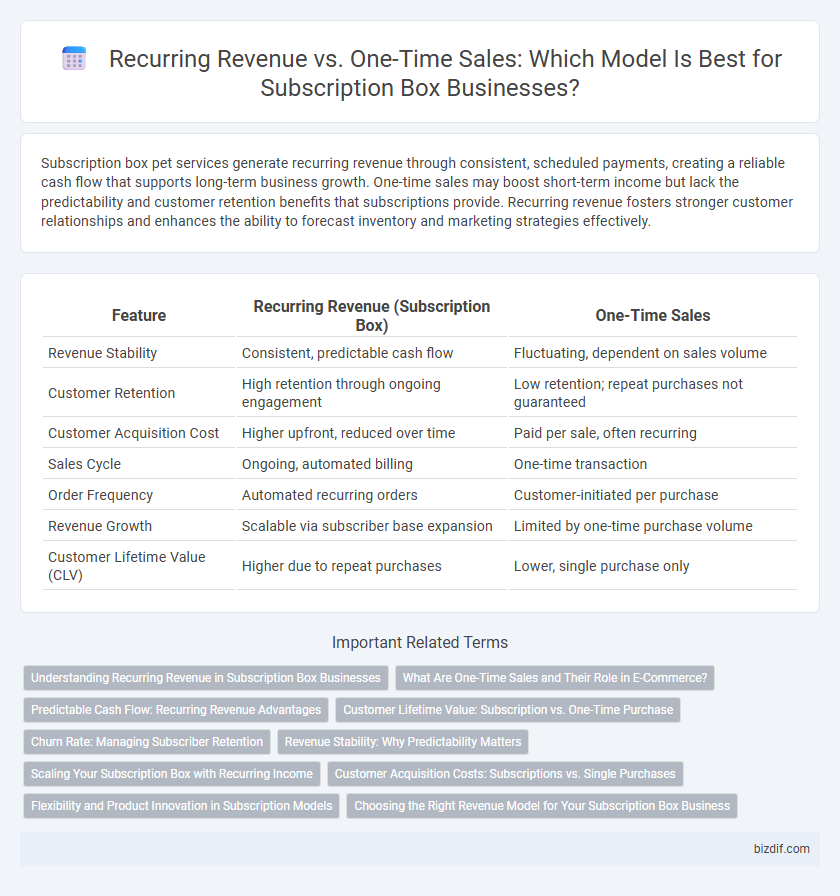Subscription box pet services generate recurring revenue through consistent, scheduled payments, creating a reliable cash flow that supports long-term business growth. One-time sales may boost short-term income but lack the predictability and customer retention benefits that subscriptions provide. Recurring revenue fosters stronger customer relationships and enhances the ability to forecast inventory and marketing strategies effectively.
Table of Comparison
| Feature | Recurring Revenue (Subscription Box) | One-Time Sales |
|---|---|---|
| Revenue Stability | Consistent, predictable cash flow | Fluctuating, dependent on sales volume |
| Customer Retention | High retention through ongoing engagement | Low retention; repeat purchases not guaranteed |
| Customer Acquisition Cost | Higher upfront, reduced over time | Paid per sale, often recurring |
| Sales Cycle | Ongoing, automated billing | One-time transaction |
| Order Frequency | Automated recurring orders | Customer-initiated per purchase |
| Revenue Growth | Scalable via subscriber base expansion | Limited by one-time purchase volume |
| Customer Lifetime Value (CLV) | Higher due to repeat purchases | Lower, single purchase only |
Understanding Recurring Revenue in Subscription Box Businesses
Recurring revenue in subscription box businesses ensures a predictable and stable income stream by charging customers on a consistent schedule, such as monthly or quarterly. This model enhances customer lifetime value and reduces dependency on acquiring new customers compared to one-time sales. Businesses benefit from improved cash flow management and scalability through building long-term subscriber relationships.
What Are One-Time Sales and Their Role in E-Commerce?
One-time sales refer to purchases made by customers without any ongoing commitment or subscription, representing immediate revenue generated from a single transaction. In e-commerce, one-time sales play a crucial role in attracting new customers, testing product-market fit, and driving short-term cash flow. These sales complement subscription models by offering flexibility and catering to consumers who prefer not to engage in recurring billing.
Predictable Cash Flow: Recurring Revenue Advantages
Subscription boxes generate predictable cash flow by securing recurring revenue streams from loyal customers, unlike one-time sales which are sporadic and less reliable. This consistency allows businesses to forecast income accurately, optimize inventory, and reduce financial risks associated with fluctuating demand. Recurring revenue models foster long-term customer relationships, increasing lifetime value and financial stability.
Customer Lifetime Value: Subscription vs. One-Time Purchase
Subscription boxes significantly increase Customer Lifetime Value (CLV) by generating predictable recurring revenue through monthly or quarterly billing cycles, fostering long-term customer relationships. One-time purchases yield immediate revenue but lack the sustained cash flow and engagement critical for maximizing CLV. Businesses leveraging subscription models often experience higher retention rates and consistent profitability compared to one-time sales strategies.
Churn Rate: Managing Subscriber Retention
Recurring revenue models in subscription boxes provide predictable income streams by ensuring consistent customer engagement, while one-time sales lack ongoing financial stability. Churn rate, indicating the percentage of subscribers who cancel their subscriptions within a given period, directly impacts profitability and growth potential in subscription businesses. Effective churn management relies on personalized marketing, product satisfaction, and seamless customer support to maintain high subscriber retention and maximize lifetime customer value.
Revenue Stability: Why Predictability Matters
Recurring revenue from subscription boxes ensures consistent cash flow, enabling better financial forecasting and operational planning. One-time sales often result in fluctuating income, making it challenging to maintain stable business growth. Predictable revenue streams reduce risks and increase the company's ability to invest in customer retention and product innovation.
Scaling Your Subscription Box with Recurring Income
Scaling your subscription box business relies heavily on the stability of recurring revenue, which provides predictable cash flow and enables better inventory and marketing planning compared to one-time sales models. Recurring income from subscription plans increases customer lifetime value (CLV) and reduces acquisition costs, allowing reinvestment into growth strategies. Emphasizing subscriber retention and upselling options can significantly boost profitability and long-term business scalability.
Customer Acquisition Costs: Subscriptions vs. Single Purchases
Subscription box models generate recurring revenue, significantly reducing Customer Acquisition Costs (CAC) over time compared to one-time sales, where CAC must be continually reinvested to attract new buyers. The predictable income stream from subscriptions allows businesses to recover acquisition costs faster and allocate marketing budgets more efficiently. In contrast, single purchase models face higher CAC per transaction since each sale requires a new customer engagement effort without guaranteed repeat business.
Flexibility and Product Innovation in Subscription Models
Subscription box models generate recurring revenue by offering customers consistent product delivery, enhancing cash flow stability and long-term forecasting. Their flexibility allows businesses to tailor offerings based on subscriber preferences and feedback, driving continuous product innovation and personalized experiences. One-time sales lack this adaptive potential, limiting opportunities for sustained engagement and iterative development.
Choosing the Right Revenue Model for Your Subscription Box Business
Selecting the appropriate revenue model for your subscription box business requires evaluating recurring revenue streams versus one-time sales opportunities. Recurring revenue from subscription plans ensures predictable cash flow, higher customer lifetime value, and improved financial stability. One-time sales can boost short-term income but lack long-term sustainability and customer engagement compared to subscription-based models.
Recurring revenue vs One-time sales Infographic

 bizdif.com
bizdif.com